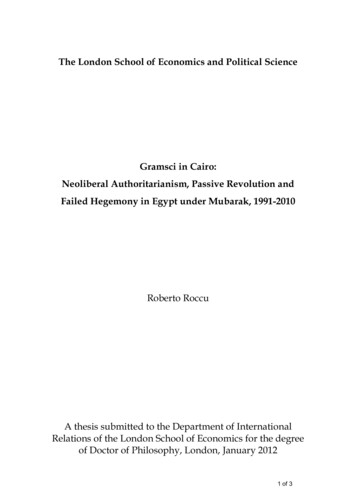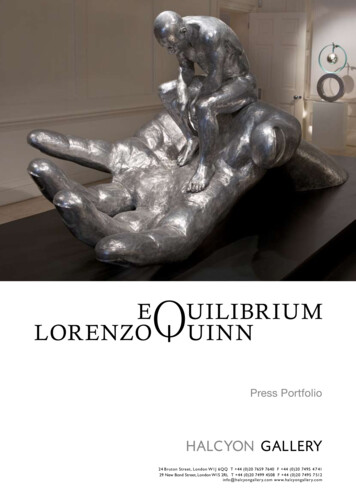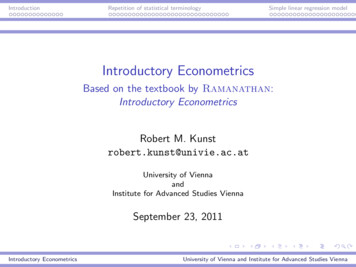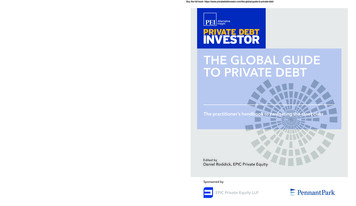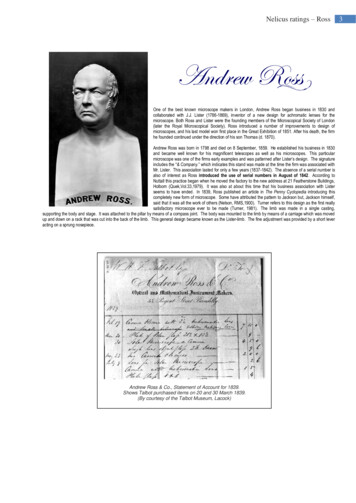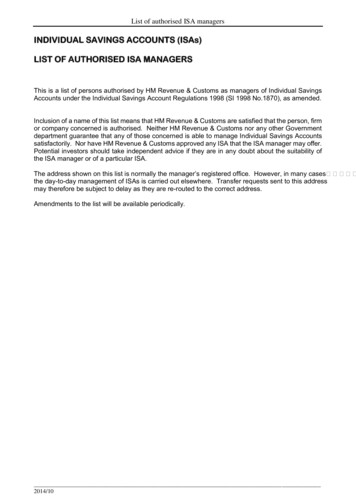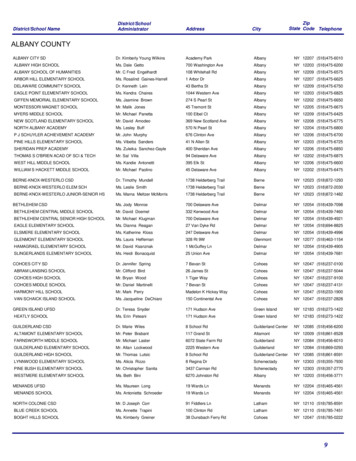
Transcription
Gregory Connor and Mason WooAn Introduction to Hedge FundsIntroductory Guide
1IntroductionInternational Asset Management (‘IAM’) is the proud sponsor of the IAMHedge Fund Research Programme of the Financial Markets Group. Withinthis programme the LSE team undertakes independent research into aspectsof the hedge fund industry. It is hoped that the results of this research willgive greater understanding about this growing area of financial innovation.This research paper gives a broad introduction to the hedge fund industry, thehistorical background to the evolution of hedge funds, the fund of fundsindustry and provides an explanation of some of the terminology used withinthis area.As an overview of the industry the document does not attempt to address theuse of hedge funds within the broader context of portfolio management suchas organisational risk or other areas of concern for the investor. This is a nontechnical paper and as such is intended for students or practitioners seeking ageneral introduction and reference tool. It is not a survey of the researchliterature and citations are kept to a minimum.If you wish to keep updated on the IAM Hedge Fund Research Programmeplease let us know. If you have any questions please contact IAM at ourLondon office or visit our website:34 Sackville StreetLondon W1S 3EFTel. 44 (0)20 7734 8488www.iam.uk.comFor information about the research activities of the Financial Markets Groupsee the following page or visit the FMG website (http://fmg.lse.ac.uk.)
London School of Economics Financial Markets GroupThe Financial Markets Group (‘FMG’) research centre was established in1987 at the LSE. FMG is now one of the leading centres in Europe foracademic research into financial markets.The FMG has developed strong links with the financial community, inparticular investment banks, commercial banks and regulatory bodies andattracts support from a large number of City institutions, both private andpublic.The FMG is led by Professor David Webb and Professor Charles Goodhartand brings together a core team of senior academics and young researchers toundertake cutting edge theoretical and empirical research in the areas offinancial markets, financial decision-making and financial regulation.Through its Visitors’ Programme the FMG attracts each year some of theworld’s renowned finance academics and outstanding researchers whoparticipate fully in the FMG’s research activities.Research at the FMG is conducted through a number of thematic researchprogrammes. Each thematic programme hosts a number of associated projectson key research areas and the Centre’s dissemination activities such asseminars, conferences, public lectures and publications are organized aroundthe FMG’s research programme structure.Gregory Connor is a professor of finance and director of the IAM/FMGHedge Fund Research Programme, and Mason Woo is a graduate student inthe risk and regulation programme at London School of Economics.
Gregory Connor and Mason WooAn Introduction to Hedge FundsIntroductory Guide
Table of Contents1 What is a Hedge Fund?1.1 Standard Definitions of a Hedge Fund1.2 The Legal Structures of Hedge Funds1.3 Legal Structures for Non-US Hedge Funds2 The History of Hedge Funds2.1 The First Hedge Fund2.2 Hedge Funds from the 1960s to the 1990s2.3 Long Term Capital Management2.4 Development of Funds of Funds2.5 Size and Growth of the Hedge Fund Industry3 Hedge Fund Fee Structures3.1 Performance-based Fees3.2 Determining Incentive Fees: High Water Marks and Hurdle Rates3.3 Equalisation3.4 Minimum Investment Levels3.5 Fees for Funds of Funds4 Hedge Fund Investment Strategies4.1 Strategy Categories for Hedge Funds4.2 Long-Short4.3 Relative Value4.4 Event Driven4.5 Tactical Trading5 Risk Management5.1 Sources of Risk5.2 Measuring Hedge Fund Risk6 Hedge Fund Performance Measurement6.1 Hedge Fund Indices6.2 Data Biases: Selection, Survivorship, and Closed Funds7 920202122232323242525272729313131333436
1 What is a Hedge Fund?1.1Standard Definitions of a Hedge FundA hedge fund can be defined as an actively managed, pooled investmentvehicle that is open to only a limited group of investors and whoseperformance is measured in absolute return units. However, this simpledefinition excludes some hedge funds and includes some funds that are clearlynot hedge funds. There is no simple and all-encompassing definition.The nomenclature “hedge fund” provides insight into its original definition.To “hedge” is to lower overall risk by taking on an asset position that offsetsan existing source of risk. For example, an investor holding a large position inforeign equities can hedge the portfolio’s currency risk by going shortcurrency futures. A trader with a large inventory position in an individualstock can hedge the market component of the stock’s risk by going shortequity index futures. One might define a hedge fund as an informationmotivated fund that hedges away all or most sources of risk not related to theprice-relevant information available for speculation1.In our technical context, speculation is defined as any action, with some non-zero risk,made in order to make a profit. This classic definition of speculation also includes thecareful research of undervalued securities for long-term gain – what is informally termed“investing”. In informal contexts, the word speculation has acquired the implicit meaningof actions based on inconclusive evidence and the desire for short-term, high-risk profit.For an excellent description of how the word speculation has evolved, see Longstreth,Bevis, Modern Investment Management and the Prudent Man Rule, Oxford UniversityPress, 1986, p. 86-89.1
6Note that short positions are intrinsic to hedging and are critical in theoriginal definition of hedge funds.Alternatively, a hedge fund can be defined theoretically as the “purely active”component of a traditional actively-managed portfolio whose performance ismeasured against a market benchmark. Let w denote the portfolio weights ofthe traditional actively-managed equity portfolio. Let b denote the marketbenchmark weights for the passive index used to gauge the performance ofthis fund. Consider the active weights, h, defined as the differences betweenthe portfolio weights and the benchmark weights:h w–bA traditional fund has no short positions, so w has all nonnegative weights;most market benchmarks also have all nonnegative weights. So w and b arenonnegative in all components but the “active weights portfolio”, h, has anequal percentage of short positions as long positions. Theoretically, one canthink of the portfolio h as the hedge fund implied by the traditional activeportfolio w.The following two strategies are equivalent:1. Hold the traditional actively-managed portfolio w2. Hold the passive index b plus invest in the hedge fund h.Defined in this way, hedge funds are a device to separate the “purely active”investment portfolio h from the “purely passive” portfolio b. The traditionalactive portfolio w combines the two components.This “theoretical” hedge fund is not implementable in practice since shortpositions require margin cash. Note that the “theoretical hedge fund”described above has zero net investment and so no cash available for margin
7accounts. If the benchmark includes a positive cash weight, this can bere-allocated to the hedge fund. Then the hedge fund will have a positiveoverall weight, consisting of a net-zero investment (long and short) inequities, plus a positive position in cash to cover margin.Why might strategy 2 above (holding a passive index plus a hedge fund) bemore attractive than strategy 1 (holding a traditional actively-managedportfolio)? It could be due to specialisation. The passive fund involves purecapital investment with no information-based trading. The hedge fundinvolves pure information-based trading with no capital investment. Thetraditional active manager has to undertake both functions simultaneouslyand so cannot specialise in either.This theoretical definition of a hedge fund also explains the “hedge”terminology. Suppose that the traditional actively-managed fund has beenconstructed so that its exposures to market-wide risks are kept the same as inthe benchmark. Then the implied hedge fund has zero exposures to marketwide risks, since the benchmark and active portfolio exposures cancel eachother out, ie, hedging.What we have just described is a “classic” hedge fund, but the operationalcomposition of hedge funds has steadily evolved until it is now difficult todefine a hedge fund based upon investment strategies alone. Hedge funds nowvary widely in investing strategies, size, and other characteristics.Hedge fund managers are usually motivated to maximise absolute returnsunder any market condition. Most hedge fund managers receive asymmetricincentive fees based on positive absolute returns and are not measured againstthe performance of passive benchmarks that represent the overall market.Hedge fund management is fundamentally skill-based, relying on the talentsof active investment management to exceed the returns of passive indexing.
8Hedge fund managers have flexibility to choose from a wide range ofinvestment techniques and assets, including long and short positions instocks, bonds, and commodities. Leverage is commonly used (83% of funds)to magnify the effect of investment decisions [Liang, 1999]. Fund managersmay trade in foreign currencies and derivatives (options or futures), and theymay concentrate, rather then diversify, their investments in chosen countriesor industry sectors. Hedge fund managers commonly invest their own moneyin the fund, which further aligns their personal motivation with that ofoutside investors.Some hedge funds do not hedge at all; they simply take advantage of the legaland compensatory structures of hedge funds to pursue desired tradingstrategies. In practice, a legal structure that avoids certain regulatoryconstraints remains a common thread that unites all hedge funds. Hence it ispossible to use their legal status as an alternative means of defining a hedge fund.1.2The Legal Structures of Hedge FundsHedge funds are clearly recognisable by their legal structures. Many peoplethink that hedge funds are completely unregulated, but it is more accurate tosay that hedge funds are structured to take advantage of exemptions inregulations. Fung and Hsieh (1999) explain the justification for theseexemptions is that the regulations are meant for the general public and thathedge funds are intended for well-informed, well-financed, private investors.The legal structure of hedge funds is intrinsic to their nature. Flexibility,opaqueness, and aggressive incentive compensation are fundamental to thehighly speculative, information-motivated trading strategies of hedge funds.These features are in conflict with a highly regulated legal environment.Hedge funds are almost always organised as limited partnerships or limitedliability companies to provide pass-through tax treatment. The fund itself
9does not pay taxes on investment returns, but returns are passed through sothat individual investors pay the taxes on their personal tax bills. (If the hedgefund were set up as a corporation, profits would be taxed twice.)In the USA, hedge funds usually seek exemptions from a number of SECregulations. The Investment Company Act of 1940 contains disclosure andregistration requirements and imposes limits on the use of investmenttechniques, such as leverage and diversification [Lhabitant, 2002]. TheInvestment Company Act was designed for mutual funds, and it exemptedfunds with fewer than 100 investors. In 1996, it was amended so that moreinvestors could participate, so long as each “qualified purchaser” was eitheran individual with at least 5 million in assets or an institutional investor withat least 25 million [President’s Working Group, 1999].Hedge funds usually seek exemption from the registration and disclosurerequirements in the Securities Act of 1933, partly to prevent revealingproprietary trading strategies to competitors and partly to reduce the costsand effort of reporting. To obtain the exemption, hedge funds must agree toprivate placement, which restricts a fund from public solicitation (such asadvertising) and limits the offer to 35 investors who do not meet minimumwealth requirements (such as a net worth of over 1 million, an annual incomeof over 200,000). The easiest way for hedge funds to meet this requirementis to restrict the offering to wealthy investors.Some hedge fund managers also seek an exemption from the InvestmentAdvisers Act of 1940, which requires hedge fund managers to register asinvestment advisers. For registered managers, a fund may only charge aperformance-based incentive fee (which is typically the manager’s mainremuneration) if the fund is limited to high net-worth individuals. Somemanagers elect to register as investment advisers, because some investors mayfeel greater reassurance, and the additional restrictions are not especiallyonerous [Lhabitant, 2002].
10Hedge funds are usually more secretive than other pooled investmentvehicles, such as mutual funds. A hedge fund manager may want to acquireher positions quietly, so as not to tip off other investors of her intentions. Ora fund manager may use proprietary trading models without wanting toreveal clues to her systematic approach. With so much flexibility and privacyconferred to managers, investors must heavily rely upon managers’judgement in investment selection, asset allocation, and risk management.There is a fundamental conflict between the needs of hedge funds and theneeds of regulators overseeing consumer investment products. Hedge fundsneed flexibility, secrecy, and strong performance incentives. Regulators ofconsumer financial products need to ensure reliability, full disclosure, andmanagerial conservatism. Removing hedge funds from the set of regulatedconsumer investment products, and then barring or restricting generalconsumer access to them, reconciles these conflicting objectives.1.3Legal Structures for Non-US Hedge FundsThe United States has been the centre of hedge fund activity, but about twothirds of all hedge funds are domiciled outside the USA [Tremont, 2002].Often these “offshore” hedge funds are established in tax-sheltering locales,such as the Cayman Islands, the British Virgin Islands, Bermuda, theBahamas, Luxembourg, and Ireland, specifically to minimise taxes for nonUS investors. US hedge funds often set up a complementary offshore fund toattract additional capital without exceeding SEC limits on US investors[Brown, Goetzmann, and Ibbotson, 1999].In the UK, the Financial Services and Markets Act 2000 (FSMA) and thePublic Offers of Securities Regulations 1995 (POS Regulations) are statutesthat influence the creation of UK-domiciled hedge funds. The FSMA specifiesrestrictions for the marketing of hedge funds (“collective investmentscheme”) that are similar to the US, such as number of shareholders and limits
11on advertising. The POS Regulations makes restrictions on how a hedge fundis structured to be a private placement.Outside the US, UK, and tax-haven countries, the situation for hedge fundsis wide-ranging. In Switzerland, hedge funds need to be authorised by theFederal Banking Commission, but once authorised, hedge funds have fewrestrictions. Swiss hedge funds may be advertised and sold to investorswithout minimum wealth thresholds. In Ireland and Luxembourg, hedgefunds and offshore investment funds are even allowed listings on the stockexchange. On the other extreme, France has greatly restricted theestablishment of French hedge funds, and French tax authorities frown uponoffshore investing.
2 The History of Hedge Funds2.1The First Hedge FundIn 1949, Alfred Winslow Jones started an investment partnership that isregarded as the first hedge fund. Remarkably many of the ideas that heintroduced over fifty years ago remain fundamental to today’s hedge fundindustry.Jones structured his fund to be exempt from the SEC regulations described inthe Investment Company Act of 1940. This enabled Jones’ fund to use awider variety of investment techniques, including short selling, leverage, andconcentration (rather than diversification) of his portfolio.Jones committed his own money in the partnership and based hisremuneration as a performance incentive fee, 20% of profits. Both practicesencourage interest alignment between manager and outside investor andcontinue to be used today by most hedge funds.Jones pioneered combining shorting and leverage, techniques that generallyincrease risk, and used them to hedge against market movements and reducehis risk exposure. He considered himself to be an excellent stock picker, buta poor market timer, so he used a market-neutral strategy of having equal longand short positions. Jones’ long-short strategy rewarded exceptional stockselection and created a portfolio that reacted less to the vagaries of the overallmarket. He also used the capital made available from short selling as leverageto make additional investments.Jones also hired other managers, delegated authority for portions of the fund,and thus initiated the multi-manager hedge fund. The multi-managerapproach later evolved into the first fund of hedge funds [Tremont, 2002].
132.2Hedge Funds from the 1960s to the 1990sBy the mid-1960s, Jones’ fund was still active and began to inspire imitations,some from investment managers who once worked for Jones. An SEC reportdocumented 140 live hedge funds in 1968 [President’s Working Group, 1999].A stock market boom began in the late 60’s, led by a group of stocks dubbedthe Nifty Fifty, and hedge funds that followed the Jones’ long-short styleappeared to underperform the overall market. To capture the rising market,hedge fund managers altered their investing strategy. Their funds becamedirectional, abandoned the risk reduction afforded by long-short hedging,and opted for portfolios favouring leveraged long-bias exposure. During thesubsequent bear market of 1972-1974, the S&P 500 declined by a third(adjusted for dividends and splits). Funds with leveraged long-bias strategieswere battered—because of insufficient risk reduction techniques; they wereeffectively “unhedged.” As a result, many hedge funds went out of business,and hedge funds decreased in popularity for the next 10 years. A 1984 surveyby Tremont Partners identified only 68 live hedge funds, fewer than half thenumber of live funds in 1968 [Lhabitant, 2002].A mid-80s revival of hedge funds is generally ascribed to the publicitysurrounding Julian Robertson’s Tiger Fund (and its offshore sibling, theJaguar Fund). The Tiger Fund was one of several so-called global macro fundsthat made leveraged investments in securities and currencies, based uponassessments of global macroeconomic and political conditions. In 1985,Robertson correctly anticipated the end of the 4-year trend of theappreciation of the US dollar against European and Japanese currencies andspeculated in non-US currency call options. A May 1986 article inInstitutional Investor noted that since its inception in 1980, Tiger Fund had a43% average annual return, spawning a slew of imitators [Eichengreen, 1999].Hedge funds became admired for their profitability, and reviled for theirseeming destabilising influence on world financial markets. In 1992 during
14the European ERM (Exchange Rate Mechanism) crisis, George Soros’Quantum Fund, another global macro hedge fund, made over a billion dollarsfrom shorting the British pound. During the “Asian Contagion” currencycrisis, the Thai Baht fell 23% in July 1997. Quantum Fund had shorted theBaht and gained 11.4% that month [Fung and Hsieh, 2000]. Spectacularsuccess stories like these increased the allure and glamour associated withhedge funds, but also established a reputation for benefiting from andcontributing to financial market chaos.In the late 90s, hedge funds made the headlines once more, but forstaggeringly large losses. In 1998, Soros’ Quantum Fund lost 2 billion duringthe Russian debt crisis. Robertson’s Tiger Fund incorrectly bet upon thedepreciation of the yen versus the dollar and lost more than 2 billion. Duringthe dot-com boom, Quantum lost almost 3 billion more from first shortinghigh-tech stocks and then reversing its strategy and purchasing stocks nearthe market top [Deutschman, 2001]. Robertson kept his Tiger Fund long on“Old Economy” and short on “New Economy” shares. Robertson wouldeventually be proved to be right, but not soon enough. Tiger Fund sustainedlosses from trading as well as mass investor redemptions and was closed downin March 2000, ironically, just before the dot-com bust which could havevalidated the fund’s strategy.2.3Long Term Capital ManagementDuring the late 90s, the largest tremor through the hedge fund industry wasthe collapse of the hedge fund Long-Term Capital Management (LTCM).LTCM was the premier quantitative-strategy hedge fund, and its managingpartners came from the very top tier of Wall Street and academia. From 19951997, LTCM had an annual average return of 33.7% after fees. At the start of1998, LTCM had 4.8 billion in capital and positions totalling 120 billion onits balance sheet [Eichengreen, 1999].
15LTCM largely (although not exclusively) used relative value strategies,involving global fixed income arbitrage and equity index futures arbitrage.For example, LTCM exploited small interest rates spreads, some less than adozen basis points, between debt securities across countries within theEuropean Monetary System. Since European exchange rates were tiedtogether, LTCM counted on the reconvergence of the associated interest rates.Its techniques were designed to pay off in small amounts, with extremely lowvolatility. To achieve a higher return from these small price discrepancies,LTCM employed very high leverage. Before its collapse LTCM controlled 120 billion in positions with 4.8 billion in capital. In retrospect, thisrepresented an extremely high leverage ratio (120/4.8 25). Banks werewilling to extend almost limitless credit to LTCM at very low no cost, becausethe banks thought that LTCM had latched onto a certain way to make money.LTCM was not an isolated example of sizeable leverage. At that time, morethan 10 hedge funds with assets under management of over 100 million wereusing leverage at least ten times over [President’s Working Group, 1999].Since the collapse of LTCM, hedge fund leverage ratios have fallensubstantially.In the summer of 1998, the Russian debt crisis caused global interest rateanomalies. All over the world, fixed income investors sought the safe havenof high-quality debt. Spreads between government debt and risky debtunexpectedly widened in almost all the LTCM trades. LTCM lost 90% of itsvalue and experienced a severe liquidity crisis. It could not sell billions inilliquid assets at fair prices, nor could it find more capital to maintain itspositions until volatility decreased and interest rate credit spreads returnedto normal.Emergency credit had to be arranged to avoid bankruptcy, the default ofbillions of dollars of loans, and the possible destabilisation of global financialmarkets. Over the weekend of September 19-20, 1998, the Federal ReserveBank of New York brought together 14 banks and investment houses with
16LTCM and carefully bailed out LTCM by extending additional credit inexchange for the orderly liquidation of LTCM’s holdings.The aftermath of the Russian debt crisis and LTCM debacle temporarilystalled the growth of the hedge fund industry. In 1998, more hedge funds diedand fewer were created than in any other year in the 1990s [Liang, 2001]. Thenumber of hedge funds as well as assets under management (AUM) declinedslightly in 1998 and the first half of 1999. Hearings were held on LTCM,resulting in recommendations for increased risk management at hedge funds,but without new legal restrictions on their practice [Lhabitant, 2002;Financial Stability Forum, 2000].LTCM proved to be a bump, rather than a derailing of the hedge fundindustry. The appeal of hedge fund investing remained, and the industryrebounded. Less than a year after the Federal Reserve Bank of New Yorkunravelled LTCM, Calpers (California Public Employees’ RetirementSystem), the largest American public pension fund, announced they wouldinvest up to US 11 billion in hedge funds [Oppel, 1999].2.4Development of Funds of FundsThe explosive growth in hedge funds led to a market for professionallymanaged portfolios of hedge funds, commonly called “funds of funds.”Funds of funds provide benefits that are similar to hedge funds, but withlower minimum investment levels, greater diversification, and an additionallayer of professional management. Some funds of funds are publicly listed onthe stock exchanges in London, Dublin, and Luxembourg. The oldest listedfund of funds on the London Stock Exchange, Alternative InvestmentStrategies Ltd., dates back to 1996.In the context of funds of funds, diversification usually means investingacross hedge funds using several different strategies, but may also mean
17investing across several funds using the same basic strategy. Funds of fundsmay offer access to hedge funds that are closed to new investors. Given thesecrecy in hedge funds, a professional funds of funds manager may havegreater expertise to conduct the necessary due diligence. Of course,professional management of a fund of hedge funds entails an additional layerof fees.2.5Size and Growth of the Hedge Fund IndustrySince hedge funds are structured to avoid regulation, even disclosure of theexistence of a hedge fund is not mandatory. There is no regulatory agency thatmaintains official hedge fund data. There are private firms that gather datathat are voluntarily reported by the hedge funds themselves. This gives anobvious source of self-selection bias, since only successful funds may chooseto report. Some databases combine hedge funds with commodity tradingadvisers (CTAs) and some separate them into two categories. Also, differenthedge funds define leverage inconsistently, which affects the determination ofassets under management (AUM), so aggregate hedge fund data are bestviewed as estimates [de Brouwer, 2001].Our theoretical derivation of a hedge fund from a traditional active fund canbe used to illustrate the problem with AUM as a measure of hedge fund size.Consider a traditional active fund with AUM of 1 Billion invested inequities. Suppose that the traditional active fund decides to re-organise itselfinto a passive index fund and an equity long-short hedge fund. Obviously theequity long-short hedge fund will need some capital to cover margin. Thetraditional fund could be re-organised as a 900 million passive index fundplus a 100 million hedge fund. If this makes the hedge fund seem too risky,it could be re-organised instead into an 800 million passive index fund plusa 200 million hedge fund. Note that the hedge fund AUM differs by a factorof two in these two cases, but the overall investment strategy is the same.
18The only difference is in the degree of leverage of the hedge fund. Clearly,AUM is not the whole story in understanding the “size” of a hedge fund, orof the hedge fund industry.Even with the caveat about data reliability and the usefulness of AUM, thegrowth of the hedge fund industry is apparent. In 1990, Lhabitant (2002)estimates there were about 600 hedge funds with aggregate AUM less than 20 billion; Agarwal and Naik (2000) cite aggregate AUM of 39 billion. By2000, Lhabitant reports between 4000 and 6000 hedge funds in existence, withaggregate AUM between 400-600 billion. Agarwal and Naik quote aggregateAUM of 487 billion. de Brouwer (2002) summarises a wide range of end ofthe 1990s estimates: between 1082 to 5830 hedge funds and 139-400 billionin aggregate AUM. Lhabitant’s figures imply averaging at least 20%annualised growth in number of hedge funds and 35% in AUM. However,this was also a period of tremendous growth in the overall equities market.Over the decade, the number of mutual funds grew at 23% annualised and thecapitalisation of the New York Stock Exchange grew at 17.5% annualised[Financial Stability Forum, 2000].Most hedge funds are small (as measured by AUM), but theuncharacteristically large hedge funds are the most well known and managemost of the money in the hedge fund industry. The Financial Stability Forum(2000) reports 1999 estimates that 69% of hedge funds have AUM under 50million, and only 4% have AUM over 500 million. Despite the number ofsmaller funds, larger hedge funds dominate the industry. Global macrostrategy funds, such as Caxton, Moore, Quantum (Soros), and Tiger(Robertson), manage billions of dollars, attract most of the attention, andestablish much of the reputation of the hedge fund industry. For example, ahedge fund index (HFR) used in research by Agarwal and Naik (2000)incorporates hedge funds with average assets of 270 million (non-directionalstrategies) and 480 million (directional strategies). In their selection process,hedge fund index providers have considerable leeway and may be likely tofavour funds that they judge to be more reliable.
3 Hedge Fund Fee Structures3.1Performance-based FeesHedge fund managers are compensated by two types of fees: a managementfee, usually a percentage of the size of the fund (measured by AUM), and aperformance-based incentive fee, similar to the 20% of profit that AlfredWinslow Jones collected on the very first hedge fund. Fung and Hsieh (1999)determine that the median management fee is between 1-2% of AUM and themedian incentive fee is 15-20% of profits. Ackermann et al. (1999) cite similarmedian figures: a management fee of 1% of assets and an incentive fee of 20%(a so-called “1 and 20 fund”).The incentive fee is a crucial feature for the succes
hedge funds are intended for well-informed, well-financed, private investors. The legal structure of hedge funds is intrinsic to their nature. Flexibility, opaqueness, and aggressive incentive compensation are fundamental to the highly speculative,
